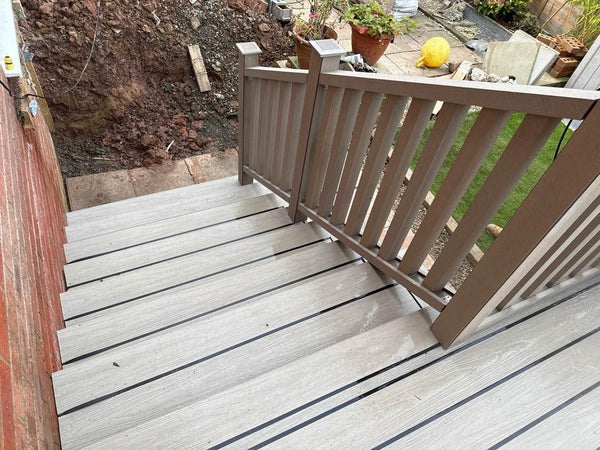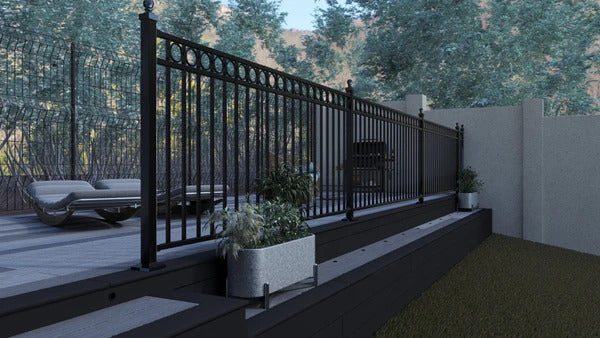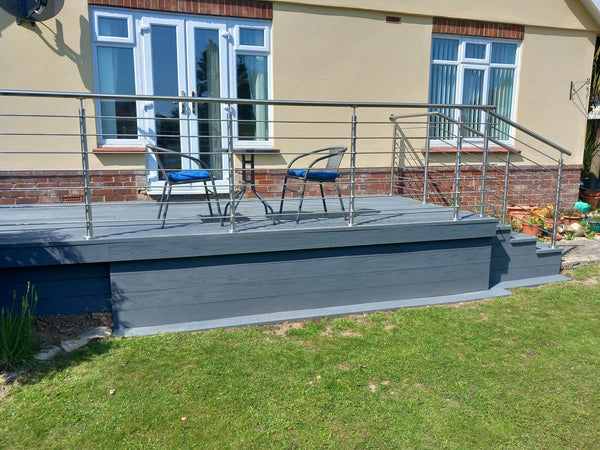We understand that selecting the right types of banisters is crucial for enhancing both the functionality and aesthetic appeal of your outdoor spaces.
With a myriad of options available, from the sleek modernity of glass and metal, and the innovative durability of composite materials, navigating through the choices can seem daunting.
This article aims to demystify the process, offering insights into the various banister types and materials, and how they can complement your outdoor decking and accessories.
What this article covers:What Is a Banister?
What is a banister on stairs? A banister plays a pivotal role in the architecture of staircases, serving multiple purposes that extend beyond mere functionality.
Comprising uprights, also known as balusters or spindles, and a handrail, a banister is a fundamental component that ensures safety by preventing falls and slips on the stairs. It offers a sturdy grip for individuals, providing essential support for those who may find ascending or descending stairs challenging.
However, the significance of a banister transcends its practical utility. It acts as a vital design element, with the potential to enhance the visual appeal of any space.
The choice of style, material, and design of a banister can complement the architectural aesthetics, making it a statement piece that reflects the homeowner's taste and the home's overall design theme.
Banister Vs Handrail: What's The Difference?
The terms 'banister' and 'handrail' are often used interchangeably in everyday conversation, yet they denote distinct components of a staircase. Understanding the difference is crucial for anyone looking to install or renovate their staircases.
A banister refers to the complete assembly that lines the side of a staircase, which includes the handrail, balusters, and sometimes a base rail that ties the structure together.
The handrail, on the other hand, is specifically the part of this assembly that people hold onto for support while moving up or down the stairs. It is an essential safety feature that can be mounted on the wall or supported by the balusters in a freestanding banister system.
While every banister has a handrail as one of its components, a handrail can exist independently of a banister, particularly in simpler or more minimalistic stair designs.
This distinction is important not only for clarity but also for making informed decisions about staircase design and safety features in both residential and commercial properties.
Banister Types
Diving into the types of banisters, we've put several to the test and here's what we've found:
Traditional Banisters
Traditional banisters are a nod to the craftsmanship and aesthetic values of bygone eras, often characterised by their use of rich, dark wood tones.

The warmth and elegance of traditional banisters make them an excellent choice for those looking to infuse their outdoor spaces with a sense of timeless beauty and sophistication.
Whether it's a grand staircase leading to a garden or a simple set of steps on a porch, a traditional banister can elevate the space with its refined charm.
Modern Banisters
In the realm of modern banisters, the emphasis is on simplicity, functionality, and clean aesthetics. These banisters often incorporate materials like stainless steel, tempered glass, or even cables, creating a look that is both sleek and contemporary.
The minimalist design of modern banisters allows them to blend seamlessly with the surrounding environment, making them ideal for outdoor spaces that celebrate modern architecture and design.
Their unobtrusive nature doesn't detract from the landscape or views, making them a popular choice for decks and balconies where the focus is on the outdoors.
Rustic Banisters
Rustic banisters are all about bringing the natural beauty and warmth of the countryside into your outdoor space. They often showcase the natural grain and texture of wood composites, sometimes with a distressed or weathered finish to enhance their rustic appeal.
These banisters might feature chunky, hand-hewn balusters or rails, and are sometimes combined with elements like metal to add to their earthy, rugged charm.
In our experience, rustic banisters are perfect for creating a cosy, inviting outdoor area that feels like an extension of the natural landscape, offering a peaceful retreat from the hustle and bustle of modern life.
Industrial Banisters
Industrial-style banisters capture the raw, utilitarian spirit of industrial design, often featuring exposed metalwork, simple geometric shapes, and a focus on functionality. Materials like steel are common, sometimes combined with elements like composite materials to add texture and interest.

The rugged, unfinished look of industrial banisters brings a contemporary edge to outdoor spaces, complementing urban gardens, loft-style terraces, and modern industrial-themed homes.
They're particularly suited to those who appreciate a more minimalist approach but want to make a bold design statement.
Types of Banister Materials
The choice of material for a banister not only impacts its appearance but also its durability and maintenance requirements. Here's a deeper dive into some popular banister materials:
Metal
Metal banisters are a testament to the versatility and strength that metal materials can bring to staircase design.
Stainless steel handrails, known for their sleek, modern appearance and resistance to corrosion, make for a stunningly minimalist and contemporary banister that can withstand the elements, especially in outdoor settings.
Metal banisters are not only about aesthetics; their durability and strength provide a sturdy support system, making them a practical choice for both indoor and outdoor applications.
Glass
Glass banisters are the epitome of modern elegance, bringing a light and airy feel to any staircase while still providing the necessary safety features. These banisters are often made from tempered or laminated glass, which is incredibly strong and resistant to impact, ensuring durability and safety.
The transparency of glass allows for uninterrupted views, making it an excellent choice for outdoor decks or balconies where the landscape is a key feature.

Glass banisters can be framed with metal or wood for added structural support and aesthetic contrast, or they can be installed with minimal hardware for a sleek, floating appearance. So if you're looking for a sleek and modern take on an outdoor handrail, one of our glass balustrades is the way to go.
Composite
Composite materials are becoming increasingly popular in banister design due to their unique blend of aesthetic appeal and practical benefits.
Composites, often made from a mixture of wood fibers and plastic, mimic the natural look and texture of wood but without the susceptibility to rot, warping, or insect damage. This makes them an ideal choice for outdoor banisters, where durability and low maintenance are key considerations.
Composite balustrades come in a variety of colours and finishes, allowing for customisation to fit any design style, from traditional to contemporary. They are also environmentally friendly, often made from recycled materials, making them a sustainable choice for eco-conscious homeowners.
Conclusion
From the timeless elegance of traditional and rustic designs to the sleek minimalism of modern and industrial styles, banisters offer an array of options to enhance the aesthetic and safety of your outdoor spaces.
The choice of material, be it the durable and stylish metal, the contemporary and airy glass, or the low-maintenance and eco-friendly composite, further allows for customisation to suit your specific design preferences and practical needs.
As you consider adding or upgrading a banister to your outdoor area, remember that the right selection can transform your space, marrying form and function in perfect harmony.
For those seeking quality and style, Ovaeda stands ready to provide you with the perfect banister solutions to elevate your outdoor living experience.

Types of Banisters (FAQs)
Can I customise the design of my banister?
Yes, banisters can be highly customised to match your specific design preferences and the architectural style of your home. Many suppliers, including Ovaeda, offer a range of customisation options, from the choice of materials and colours to the design of balusters and handrails.
How long does it take to install a new banister?
The installation time for a new banister can vary depending on the complexity of the design and the materials used.
Simple installations can be completed in a day or two, while more intricate designs or those requiring custom fabrication may take longer. It's best to consult with your supplier for a more accurate timeline.
If you're looking to update or upgrade your banister, be sure to read our guides on how to replace a banister and replacing banister spindles.
Are there any building codes or regulations I need to consider when installing a banister?
Yes, there are building codes and regulations that dictate the specifications for banisters, particularly concerning banister height, the spacing of balusters, and the overall structural integrity.
These regulations are covered by Document K in the UK, so be sure to familiarise yourself with them.
How do I maintain my banister to ensure its longevity?
Maintenance requirements for banisters depend on the material. Metal banisters may need occasional painting or rust treatment, while glass banisters will need regular cleaning to maintain clarity.
Composite materials typically require the least maintenance, often needing just a simple wash with soap and water.
Did our blog meet your needs? You might also find our other guides helpful:
- Can You Put Composite Decking on Wooden Joists?
- Types of Garden Flooring
- Can You Screw Composite Decking?
- Types of Composite Decking
- Can You Put Composite Decking Over Wood Decking?
- Types of Balustrade
- Fitting Balustrade
- Balustrade Distance Between Posts
- Glass Balustrade Ideas
- Balustrade and Handrail
- Banister vs Balustrade
- Glass Balustrade Building Regulations UK
- Does Composite Decking Fade?
- Does Composite Decking Expand?
- Is Composite Decking Cheaper Than Paving?